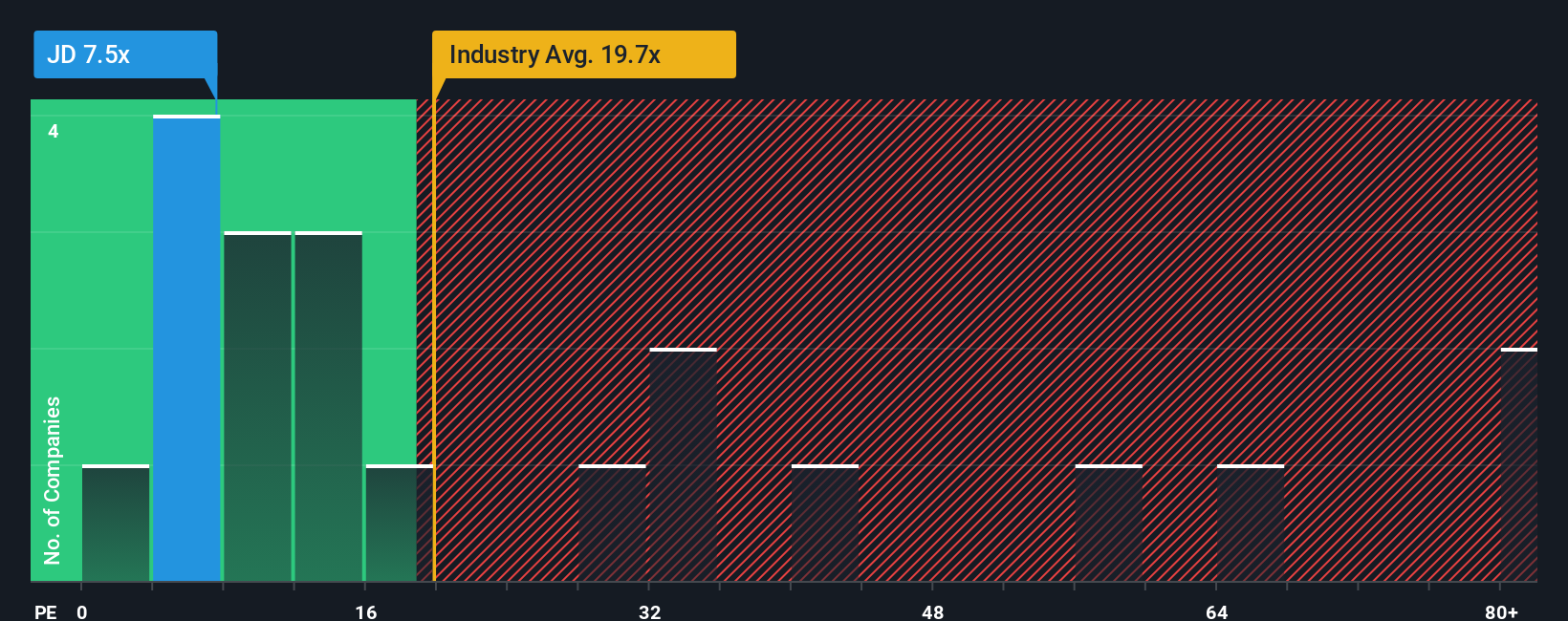JD.com, Inc.'s (NASDAQ:JD) Earnings Are Not Doing Enough For Some Investors
When close to half the companies in the United States have price-to-earnings ratios (or "P/E's") above 18x, you may consider JD.com, Inc. (NASDAQ:JD) as a highly attractive investment with its 7.5x P/E ratio. However, the P/E might be quite low for a reason and it requires further investigation to determine if it's justified.
With earnings growth that's superior to most other companies of late, JD.com has been doing relatively well. One possibility is that the P/E is low because investors think this strong earnings performance might be less impressive moving forward. If you like the company, you'd be hoping this isn't the case so that you could potentially pick up some stock while it's out of favour.
Check out our latest analysis for JD.com

Does Growth Match The Low P/E?
There's an inherent assumption that a company should far underperform the market for P/E ratios like JD.com's to be considered reasonable.
If we review the last year of earnings growth, the company posted a terrific increase of 93%. Although, its longer-term performance hasn't been as strong with three-year EPS growth being relatively non-existent overall. Therefore, it's fair to say that earnings growth has been inconsistent recently for the company.
Looking ahead now, EPS is anticipated to climb by 4.7% per year during the coming three years according to the analysts following the company. Meanwhile, the rest of the market is forecast to expand by 10% each year, which is noticeably more attractive.
In light of this, it's understandable that JD.com's P/E sits below the majority of other companies. It seems most investors are expecting to see limited future growth and are only willing to pay a reduced amount for the stock.
The Key Takeaway
Using the price-to-earnings ratio alone to determine if you should sell your stock isn't sensible, however it can be a practical guide to the company's future prospects.
We've established that JD.com maintains its low P/E on the weakness of its forecast growth being lower than the wider market, as expected. At this stage investors feel the potential for an improvement in earnings isn't great enough to justify a higher P/E ratio. It's hard to see the share price rising strongly in the near future under these circumstances.
The company's balance sheet is another key area for risk analysis. Our free balance sheet analysis for JD.com with six simple checks will allow you to discover any risks that could be an issue.
Of course, you might find a fantastic investment by looking at a few good candidates. So take a peek at this free list of companies with a strong growth track record, trading on a low P/E.
New: Manage All Your Stock Portfolios in One Place
We've created the ultimate portfolio companion for stock investors, and it's free.
• Connect an unlimited number of Portfolios and see your total in one currency
• Be alerted to new Warning Signs or Risks via email or mobile
• Track the Fair Value of your stocks
Have feedback on this article? Concerned about the content? Get in touch with us directly. Alternatively, email editorial-team (at) simplywallst.com.
This article by Simply Wall St is general in nature. We provide commentary based on historical data and analyst forecasts only using an unbiased methodology and our articles are not intended to be financial advice. It does not constitute a recommendation to buy or sell any stock, and does not take account of your objectives, or your financial situation. We aim to bring you long-term focused analysis driven by fundamental data. Note that our analysis may not factor in the latest price-sensitive company announcements or qualitative material. Simply Wall St has no position in any stocks mentioned.
About NasdaqGS:JD
JD.com
Operates as a supply chain-based technology and service provider in the People’s Republic of China.
Undervalued with excellent balance sheet.
Similar Companies
Market Insights
Community Narratives



